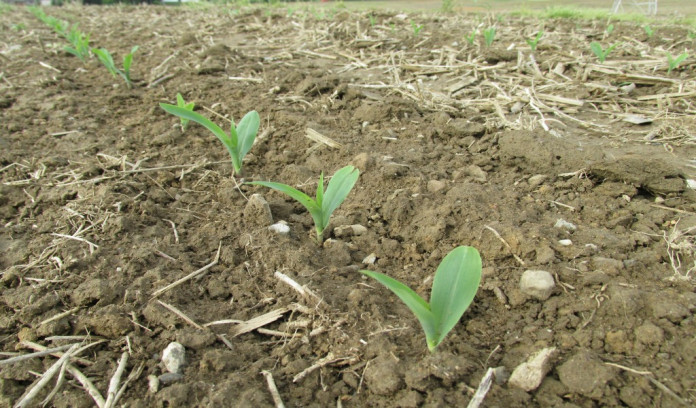Low crop margins and uncertain land value and cash rental markets will continue to be important themes as we look ahead to 2017 as producers grapple with high per bushel costs relative to crop prices received. Less than ideal weather conditions in parts of Ohio in 2016 compounded financial stress on many crop farms however insurance proceeds and USDA ARC (Agricultural Risk Coverage) and PLC (Price Loss Coverage) 2015 payments delivered in October of 2016 alleviated the potential severe stress on many farms.
According to data from the Ohio Ag Statistics Service, bare cropland value decreased .9 percent in Ohio in 2016. According to this data, bare cropland averaged $5,800/acre, down from $5,850/acre the previous year. The Western Ohio Cropland Values and Cash Rents Survey (AEDE) was conducted in January through March of 2016.
Cropland values
The projected value for “average” cropland in western Ohio was $7,034 per acre. “Top” cropland in western Ohio was projected to average $8,853 per acre while “poor” cropland in western Ohio was expected to average $5,465 per acre. These values reflect projected decreases of 6.9 to 8.1 percent.
The Chicago Federal Reserve Bank October 1 survey of bankers found land values of “good” farmland were down 3 percent from last year with the 3rd quarter showing a 1 percent decrease in farmland values across the district. In this same survey however, the data revealed a year-over-year 1 percent increase for “good” farmland in Indiana. This is seemingly at odds with the data summarized by Purdue University.
Purdue University conducted their annual land value survey in June 2016 and found year over year decreases in farmland value that ranged from 8.2 to 8.7 percent depending on land productivity class. The different survey timing may explain some of the differences in survey results however the differing results lends further confusion to the direction and magnitude of farmland value change in the eastern cornbelt.
Strong equity positions (relative to pre-2006) together with continued low interest rates continue to lend positive support to land values. Low projected profit margins in 2017 will likely restrict further land value increases and possibly cause another decrease in land values.
These competing fundamentals create a continued uncertain picture for land values in 2017 although continued low margins together with the potential for higher interest rates suggest lower farmland values in 2017. One wildcard is how producers choose to spend their USDA ARC or PLC payments. Will they retain this as working capital to insure against future years of low profit margins or will they stay aggressive in the farmland market?
Row crops
Enterprise budget projections for Ohio’s primary row crops for 2017 indicate the potential for low margins. “Returns to variable costs” (gross revenue minus variable costs) are projected to be $188-$353 per acre for Ohio corn in 2017 depending on land production capabilities. “Returns to land” (gross revenue minus all costs except land cost) for Ohio corn remains low and ranges from -$37 to $116 per acre. Estimates for “returns to total costs” for Ohio corn in 2017 are negative for all three land classes evaluated.
Budget projections for 2017 soybeans show “returns to variable costs” to be $235-414 per acre. “Returns to land” for Ohio soybeans are projected to range from $60-$230 per acre. “Returns to total costs” are projected to be negative for all three land capability classes evaluated however these figures are generally higher than corn return projections for 2017.
Wheat budget projections for 2017 show “returns to variable costs” to be between $123 and $219 per acre. Wheat return projections are generally lower than soybeans or corn at this time however straw returns and double-crop soybean returns (where optional) may significantly improve the economic viability of raising wheat in 2017.
These return calculations assume current prices of inputs and current December, November and September 2017 futures prices, respectively. These projections are based on OSU Extension Ohio Crop Enterprise Budgets available online at: http://aglaw.osu.edu/farm-management-tools
Archived budgets are available online at: http://aede.osu.edu/research/osu-farm-management/enterprise-budgets
Rental rates
Strong equity positions together with higher property taxes will continue to lend support to cash rental rates. However, low to negative projected profit margins in 2017 will continue to apply downward pressure on rents. These competing fundamentals suggest a flat to slightly lower cash rental market outlook for 2017.
Variable costs for Ohio corn for 2017 are estimated to be 1.7 percent to 2.8 percent lower compared to 2016. Variable costs for corn for 2017 are projected to be $319 to $393 per acre. Variable costs for 2017 Ohio soybeans are projected to be 2.9 percent to 3.4 percent lower and range from $182 to $196 per acre. Wheat variable expenses for 2017 are projected to range from $154 to $184 per acre, down 9.9 percent to 13.3 percent from 2016. Lower fertilizer prices will likely be the primary fundamental driver of lower variable costs in 2017.
Outlook information presented here was developed with data and/or research from OSU Extension, the Energy Information Administration, USDA, USDA ERS, USDA NASS, Purdue University, University of Illinois, Federal Reserve Bank of Chicago, DTN, futures markets and retail sector surveys. While gauged to the best of this author’s capabilities, forward looking statements contained in this document may prove to be incorrect due to changes in supply and demand and other political and economic related events.










